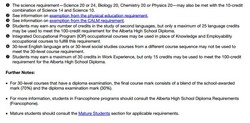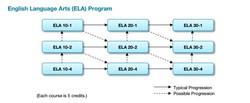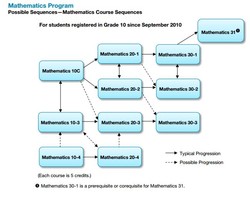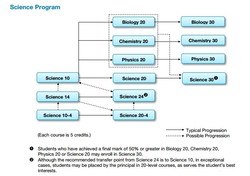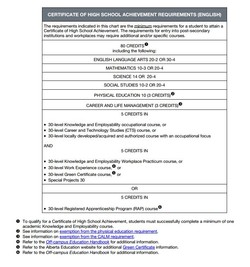Step 1 - Know Yourself
Your first goal should be to keep career doors open as possible by choosing courses which provide the most flexibility and alternatives. Decisions about Grade 10 will affect the choices available to you throughout high school and afterward. Your next goal should be to choose a program that will allow you to be successful, but that will also challenge your abilities and put you in the best possible position for post-secondary studies.
Step 2 - Know The Diploma/Certificate Requirements
Diploma Requirements
| 100 credits |
| English 30-1 or 30-2 |
| Social Studies 30-1 or 30-2 |
| Mathematics - 20-1. 20-2 or 20-3 |
| Science 20, 24, Bio 20, Chem 20 or Physics 20 |
| Physical Education 10 (min 3 credits) |
| Career & Life Management (CALM) |
| 10 additional credits (option courses-can be from 10, 20 or 30 level) |
| 10 additional credits at a 30 level |
Certificate Requirements
| 80 credits |
| English 30-4 or 20-2 |
| Social Studies 20-4 or 10-2 |
| Mathematics 20-4 or 10-3 |
| Science 20-4 or 14 |
| Physical Education 10 (min 3 credits) |
| Career & Life Management (CALM) |
| 5 work experience or RAP credits |
| 5 employabilty credits at the 30 level |
Step 3 - Know The Credit System
Each high school course is assigned a credit value. One credit is equivalent to 25 hours of instruction. All courses require a 50% mark to obtain credits. Grade 10 courses are given numbers starting with a 1 - e.g. Mathematics 10, Mechanics 1. Grade 11 courses are given numbers starting with a 2. Grade 12 courses are given numbers starting with a 3. Most courses proceed in sequence from Grade 10 through Grade 11 to Grade 12 - e.g. Art 10, 20, 30, or Social Studies 10, 20, 30, or Cosmetology 1, 2, 3. To proceed to the next course in a sequence, a minimum of 50% must be achieved in the required prerequisite course. However, in advanced courses, 50% does not ensure a reasonable chance of success and so a minimum of 65% is strongly recommended.
Step 4 - Know The Credit Loads
A high school diploma requires 100 credits. The following minimum credit loads are required:
- Grade 10: 40 credits (no spares) - 8 courses
- Grade 11: 40 credits (no spares) - 8 courses
- Grade 12: 35 credits (one spare) - 7 courses
Step 5 - Select Your Courses
When selecting your courses, consider the following
1. What courses do I need to work towards my diploma or certificate?
2. Do I have the prerequisite skills I need for the course?
3. Do I have the work habits needed to be successful in the course? (Attendance, study and homework habits)
4. What courses do I need to work towards for my anticipated post-secondary requirements?
Step 6 - Ask For Help
Your guidance counselor can help. Please email the school with questions or to set up an appointment.


